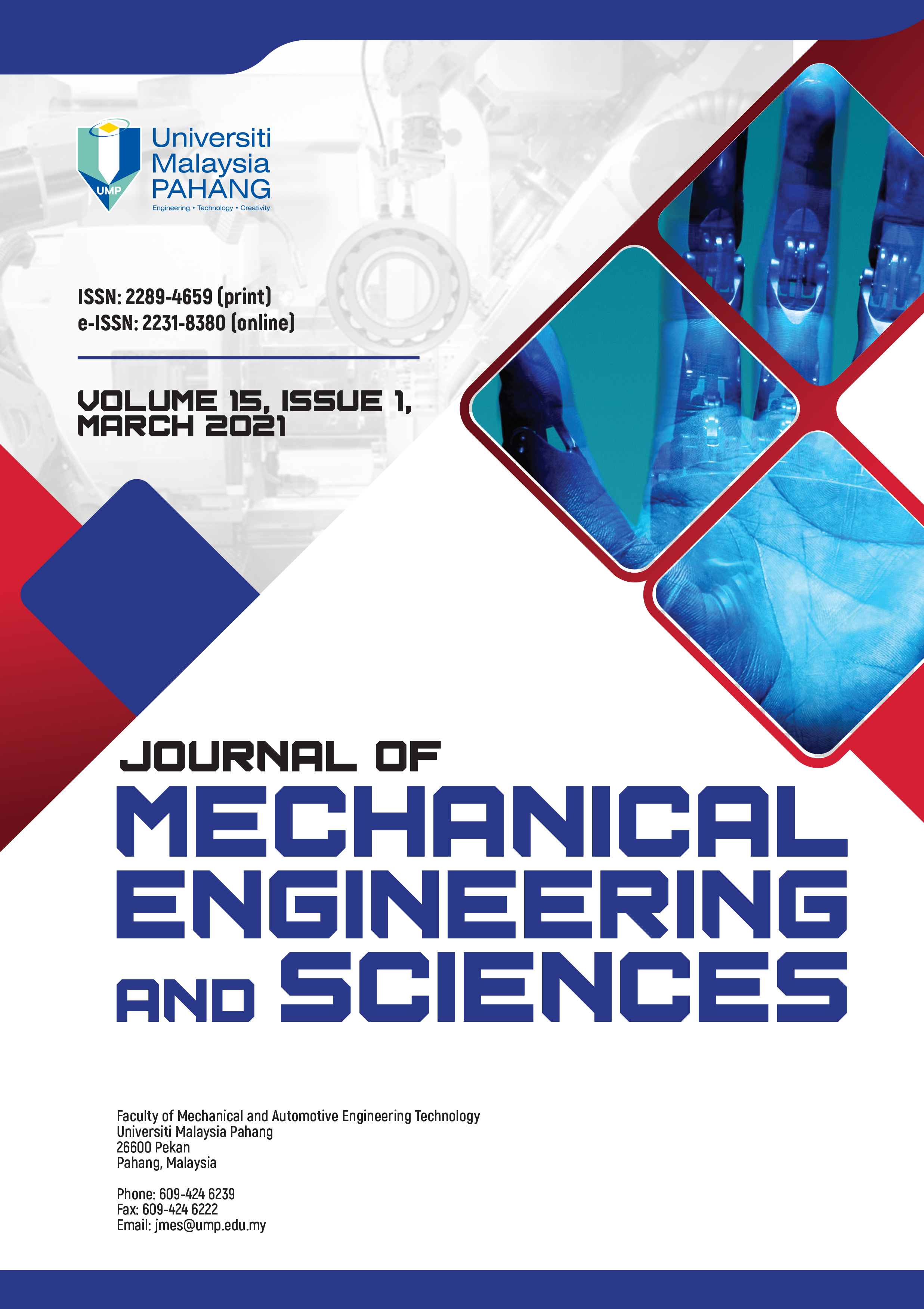Effect of rice husk ash addition on the physical properties of soda-lime-silica glass for building glass and window panel
DOI:
https://doi.org/10.15282/jmes.15.1.2021.13.0613Keywords:
Rice husk ash, Soda Lime Silica glass, elastic properties, microstructural analysis, mechanical propertiesAbstract
Demand for eco-friendly materials are increasing each year due to their excellent properties, which has proved to contribute in developing sustainable environment. One of the promising raw materials in producing glass is rice husk, a waste product from paddy harvesting, which contains about 90% of silica. Rice husks are usually burnt in an open area and contributed to serious air pollution problems. In this research, Soda-Lime-Silica Rice Husk Ash (SLRHA) glass which is a new combination of soda lime silicate (SLS) glass and rice husk ash (RHA) was developed for building glass and window application. The physical properties of the developed SLS-RHA glass system is presented in this paper. Based on the ultrasonic velocities test, sample with 5% of RHA was found to possess high and medium elastic properties including easy to bend rather than elongate, less stiff, tough at a certain direction and has low rigidity. Sample with 0% and 10% of RHA showed medium and poor elastic properties, respectively. High hardness value of the RHA glass was achieved using combinations of 60 to 120 Rockwell hardness test scale with up to 2% RHA. By considering the results from both tests, sample with 0% to 5% of RHA was considered to be the optimum formulation in the production of building glass and window panel.
References
J. Kanagaraj, T. Senthilvelan, R. C. Panda, S. Kavitha, “Eco-friendly waste management strategies for greener environment towards sustainable development in leather industry: A comprehensive review,” J. Clean. Prod., vol. 89, pp. 1–17, 2015, doi: 10.1016/j.jclepro.2014.11.013.
A. Abraham, A. K. Mathew, R. Sindhu, A. Pandey, P. Binod, “Potential of rice straw for bio-refining: An overview,” Bioresour. Technol., vol. 215, pp. 29–36, 2016, doi: 10.1016/j.biortech.2016.04.011.
R. Isaak, “The making of the ecopreneur,” Greener Manag. Int., no. 38, pp. 81–91, 2002, doi: 10.9774/GLEAF.3062.2002.su.00009.
C. S. Prasad, K. N. Maiti, R. Venugopal, “Effect of rice husk ash in whiteware compositions,” Ceram. Int., vol. 27, no. 6, pp. 629–635, 2001, doi: 10.1016/S0272-8842(01)00010-4.
M. S. Mohd Basri, F. Mustapha, N. Mazlan, M. R. Ishak, “Fire retardant performance of rice husk ash-based geopolymer coated mild steel - A factorial design and microstructure analysis,” Mater. Sci. Forum, vol. 841, pp. 48–54, 2016, doi: 10.4028/www.scientific.net/MSF.841.48.
M. Kubo and M. Purevdorj, “The Future of Rice Production and Consumption,” J. Food Distrib. Res., vol. 35, no. 1, pp. 128–142, 2004.
S. Chandrasekhar, K. G. Satyanarayana, P. N. Pramada, P. Raghavan, T. N. Gupta, “Processing, properties and applications of reactive silica from rice husk - An overview,” J. Mater. Sci., vol. 38, no. 15, pp. 3159–3168, 2003, doi: 10.1023/A:1025157114800.
F. Andreola et al., “Technological properties of glass-ceramic tiles obtained using rice husk ash as silica precursor,” Ceram. Int., vol. 39, no. 5, pp. 5427–5435, 2013, doi: 10.1016/j.ceramint.2012.12.050.
H. B. Dizaji et al., “Generation of high quality biogenic silica by combustion of rice husk and rice straw combined with pre- and post-treatment strategies-A review,” Appl. Sci., vol. 9, no. 6, pp. 1–27, 2019, doi: 10.3390/app9061083.
V. Le Houérou, J. C. Sangleboeuf, S. Dériano, T. Rouxel, G. Duisit, “Surface damage of soda-lime-silica glasses: Indentation scratch behavior,” J. Non. Cryst. Solids, vol. 316, no. 1, pp. 54–63, 2003, doi: 10.1016/S0022-3093(02)01937-3.
M. O. Prado, C. Fredericci, E. D. Zanotto, “Isothermal sintering with concurrent crystallization of polydispersed soda-lime-silica glass beads,” J. Non. Cryst. Solids, vol. 331, no. 1–3, pp. 145–156, 2003, doi: 10.1016/j.jnoncrysol.2003.08.076.
P. Mishra, A. Chakraverty, H. D. Banerjee, “Production and purification of silicon by calcium reduction of rice-husk white ash,” J. Mater. Sci., vol. 20, no. 12, pp. 4387–4391, 1985, doi: 10.1007/BF00559326.
N. H. Bateni, M. N. Hamidon, K. A. Matori, “Effect of soda-lime-silica glass addition on the physical properties of ceramic obtained from white rice husk ash,” J. Ceram. Soc. Japan, vol. 122, no. 1422, pp. 161–165, 2014, doi: 10.2109/jcersj2.122.161.
I. J. Fernandes et al., “Characterization of silica produced from rice husk ash: Comparison of purification and processing methods,” Mater. Res., vol. 20, pp. 519–525, 2017, doi: 10.1590/1980-5373-mr-2016-1043.
M. Dominic, P. M. S. Begum, A. Jose, “R i c e H u s k S i l i c a - E f f i c i e n t B i o F i l l e r i n H i g h D e n s i t y P o l y e t h y l e n e,” no. January, 2014.
V. P. Della, I. Kühn, D. Hotza, “Rice husk ash as an alternate source for active silica production,” Mater. Lett., vol. 57, no. 4, pp. 818–821, 2002, doi: 10.1016/S0167-577X(02)00879-0.
T. H. Liou, “Preparation and characterization of nano-structured silica from rice husk,” Mater. Sci. Eng. A, vol. 364, no. 1–2, pp. 313–323, 2004, doi: 10.1016/j.msea.2003.08.045.
E. Lodins et al., “Characterization of glass-ceramics microstructure, chemical composition and mechanical properties,” IOP Conf. Ser. Mater. Sci. Eng., vol. 25, no. 1, 2011, doi: 10.1088/1757-899X/25/1/012015.
T. Wasanapiarnpong, B. Vorajesdarom, E. Rujirakamort, S. Nilpairach, C. Mongkolkachit, “Fabrication of silica glass from rice husk ash with spodumene additions,” IOP Conf. Ser. Mater. Sci. Eng., vol. 18, no. SYMPOSIUM 16, 2011, doi: 10.1088/1757-899X/18/22/222028.
J. Partyka and M. Leśniak, “Preparation of glass-ceramic glazes in the SiO2-Al2O3-CaO-MgO-K2O-Na2O-ZnO system by variable content of ZnO,” Ceram. Int., vol. 42, no. 7, pp. 8513–8524, 2016, doi: 10.1016/j.ceramint.2016.02.077.
D. Gross and T. Seelig, Fracture Mechanics With an Introduction to Micromechanics Third Edition. Springer International Publishing, 2018.
M. I. Mustaffar, M. H. Mahmud, M. A. Hassan, “Development of dense glass-ceramic from recycled soda-lime-silicate glass and fly ash for tiling,” AIP Conf. Proc., vol. 1901, 2017, doi: 10.1063/1.5010476.
E. M. A. Khalil, F. H. ElBatal, Y. M. Hamdy, H. M. Zidan, M. S. Aziz, A. M. Abdelghany, “Infrared absorption spectra of transition metals-doped soda lime silica glasses,” Phys. B Condens. Matter, vol. 405, no. 5, pp. 1294–1300, 2010, doi: 10.1016/j.physb.2009.11.070.
K. A. Matori, M. H. M. Zaid, H. A. A. Sidek, M. K. Halimah, Z. A. Wahab, M. G. M. Sabri, “Influence of ZnO on the ultrasonic velocity and elastic moduli of soda lime silicate glasses,” Int. J. Phys. Sci., vol. 5, no. 14, pp. 2212–2216, 2010.
Y. B. Saddeek, “Ultrasonic study and physical properties of some borate glasses,” Mater. Chem. Phys., vol. 83, no. 2–3, pp. 222–228, 2004, doi: 10.1016/j.matchemphys.2003.09.051.
Downloads
Published
Issue
Section
License
Copyright (c) 2021 The Author(s)

This work is licensed under a Creative Commons Attribution-NonCommercial 4.0 International License.






